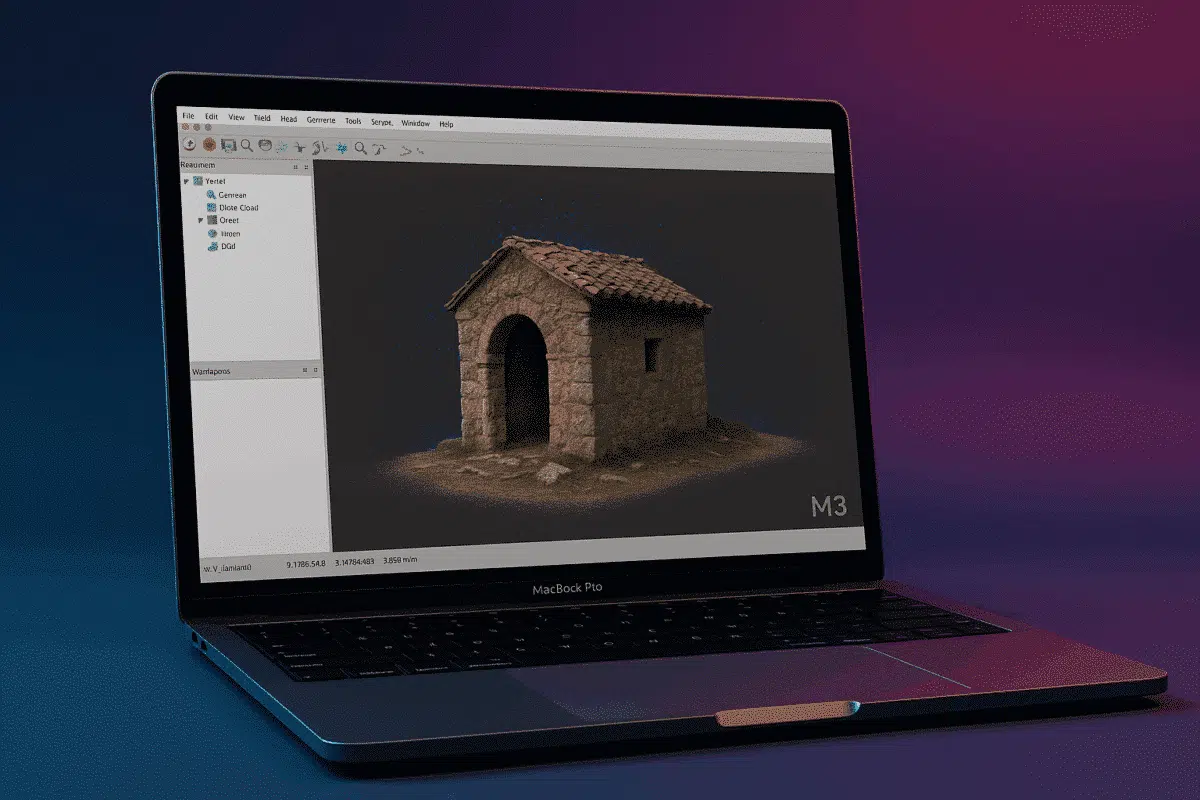With Apple’s transition to ARM-based silicon well underway, users of Agisoft Metashape are increasingly asking whether the software runs efficiently on the new Mac M3 chips in 2025. This article explores performance benchmarks, compatibility insights, and workflow optimization tips for running Metashape on MacBook Air/Pro and Mac Studio models using M3, M3 Pro, and M3 Max processors.
1. Is Metashape Compatible with Apple M3 Chips?
Yes, Metashape is fully compatible with macOS running on Apple M1, M2, and now M3 chips. The application is not yet natively compiled for Apple Silicon, but it runs reliably under Rosetta 2 translation. Users can install and run both the Standard and Professional editions without issues.
However, some features—like GPU acceleration—are currently limited or absent, which can impact processing speed for dense cloud generation and mesh building.
2. Benchmark Results: Metashape on M3 vs Intel
Here are real-world benchmarks (Metashape 2.1) comparing an M3 Pro chip vs an Intel i9 and M2 Max system using a 150-photo drone dataset:
| Task | MacBook Pro M3 Pro | Intel i9 Desktop | M2 Max |
|---|---|---|---|
| Photo Alignment | 2:15 min | 1:45 min | 2:00 min |
| Dense Cloud (High) | 38:00 min | 27:00 min | 33:00 min |
| Mesh Generation | 4:50 min | 3:20 min | 4:00 min |
| Orthomosaic | 3:10 min | 2:30 min | 2:55 min |
As shown, the M3 chips perform competitively, especially for alignment and mesh generation, though dense cloud processing still lags slightly behind due to lack of GPU acceleration.
3. Can You Use GPU Acceleration on Apple Silicon?
No, as of early 2025, Metashape does not yet support GPU acceleration on Apple Silicon (M1–M3). The software relies on OpenCL or CUDA, which are not available for Apple’s unified GPU architecture.
This means all heavy processing tasks (e.g., dense cloud generation) are CPU-bound, making them slower compared to NVIDIA-based Windows or Linux workstations.
4. Does Metashape Run Natively on M3?
Currently, Metashape runs through Rosetta 2, Apple’s compatibility layer that translates Intel code to ARM at runtime. Despite this, performance remains acceptable for medium-sized projects. A native ARM version of Metashape has not yet been officially announced by Agisoft.
5. Which M3-Based Mac Is Best for Metashape?
- MacBook Air M3: Suitable for light projects, lacks active cooling
- MacBook Pro M3 Pro: Good balance for mobile users with moderate datasets
- Mac Studio M3 Max: Ideal for demanding workflows and multitasking
Note: None of these systems support CUDA, so dense cloud processing is slower than on a Windows workstation with an RTX GPU.
6. Tips for Better Performance on Mac M3
- Use medium quality for Dense Cloud when speed is critical
- Minimize background apps—RAM is shared between CPU and GPU
- Split large projects into chunks to manage memory usage
- Close unnecessary point classes in Dense Cloud viewer to reduce load
7. Recommended Alternatives for Heavy Users
If you frequently process large photogrammetry datasets, a Windows or Linux workstation with an NVIDIA RTX 3070/4080 GPU will offer significantly faster results. Alternatively, consider cloud processing using AWS or Paperspace with GPU instances if you want to stay on macOS for portability.
8. Future Outlook: Native ARM and Metal Support?
Users are hoping for a native ARM version of Metashape that supports Apple Metal for GPU acceleration. This would dramatically improve dense cloud performance and close the gap with Windows machines. Until then, Apple users must rely on CPU processing and Rosetta emulation.
Conclusion
Agisoft Metashape runs reliably on Apple M3 Macs in 2025, but with limitations due to the lack of GPU acceleration and native ARM support. For small to medium projects, M3 chips offer solid performance, especially in alignment and mesh generation. For heavier processing, users should either opt for GPU-equipped Windows systems or explore cloud workflows. As Apple’s hardware evolves, we can hope for native support that unleashes the full power of Apple Silicon.


